
Dublin Bus: At the heart of Ireland’s sustainability journey
11th November 2022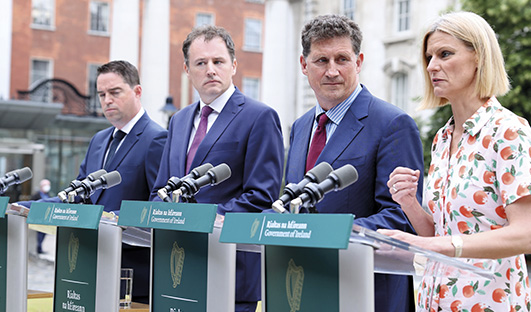
Sectoral emissions ceilings fall short of 2030 target
3rd January 2023One day before the Government announced agreement on the sectoral emissions ceilings, Minister for Agriculture, Food and the Marine, Charlie McConalogue TD, sat down in his department’s Kildare Street headquarters with Ciarán Galway to discuss Ireland’s agricultural policy, climate action, and the future of agri-food.
As negotiations on the sectoral emissions ceilings linger two weeks beyond the arrival of the Dáil summer recess, in late July 2022, Charlie McConalogue cuts an embattled figure as a government minister under pressure. For weeks, accounts of fraught cabinet meetings have been reported across the media spectrum. Ireland’s farming population and environmental activists are respectively wary of betrayal amid triparty coalition horse-trading.
Priorities
As such, the role of the modern agriculture minister is defined by a fine balancing act. Alongside a Programme for Government pledge to support “farm families”, ensuring sustainable incomes across the food and fisheries sectors, McConalogue is cognisant of the challenge of reducing agricultural emissions. Simultaneously, he wants to ensure that Ireland retains its agrifood productivity.
“We do not want to see a reduction in the amount that is being produced but we want to see a reduction in the emissions that come from agriculture, so it is about striking that appropriate balance and then working across the economy to seek to deliver that 51 per cent reduction [by 2030]. That is something that we are going to keep under review as the decade progresses,” he insists.
Buoyed by intimate knowledge of his brief – informed, in part, by his experience on his own family’s farm – the Minister feels that he carries a deep appreciation of the role which has instilled a capacity to lead the sector. Charting the Government’s trajectory over the previous 18 months, the Minister identifies the new 10-year Food Vision 2030 strategy for the agri-food sector, preliminary agreement on Ireland’s Common Agricultural Policy Strategic Plan (CSP) for the period from 2023 to 2027, and the ongoing development of the Seafood Development Programme 2021-27 as driving the agriculture vision in this decade.
“Overall, in terms of agriculture and food, it has been a time of challenge but also a time of progress. There is a very strong future for the sector given the growing importance of food, our capacity to produce it, and in a way that is really sustainable,” he reflects.
CAP
Having undertaken a tour of the country’s marts in 2021, addressing farmers in a “nationwide Common Agricultural Policy (CAP) consultation tour”, McConalogue sought to inform the development of the CAP which will be the key delivery vehicle for agricultural policy and funding from January 2023 until the end of 2027.
“My key objective was to ensure that all farmers – regardless of the type of farming that they do or the part of the country they are from – have the opportunity to have their say, to feed into the draft proposals on the CAP,” he suggests, adding: “It definitely helped to ensure that the final CAP programme was balanced.”
Following the announcement of the CSP package in October 2021, McConalogue gained much respect within the farming community, having continued his tour of the marts in the face of Irish Farmers’ Association (IFA) protests.
Reflecting on that time, the Minister asserts that the “robust discussions” that took place on the tour indicated that “farmers were engaging” and illustrated the high stakes for farmers in relation to CAP meaning that the “outcome of the policy was a lot stronger”.
National farming model
Unlike other agricultural models across the world, which are typified by housed systems, Ireland’s national farming model is distinct in that it utilises a grass-based pasture production system. As such, much of Irish agriculture revolves around growing grass for grass-based livestock, and grass-based milk production.
“Irish farmers are very much aware of the fact that the marketability and attraction of Irish food is about how we produce it, the sustainability, and the environment in which we produce it.”
Minister for Agriculture, Food and the Marine, Charlie McConalogue TD
“The thing that distinguishes ours from other agricultural models is the fact that we do have a grazing-based, pasture-based agricultural system and that is quite unique. That gives a real differential to the type of product that we have. We have grass-fed beef and grass-fed dairy,” McConalogue explains.
“That gives us a real advantage in terms of the quality of the produce, the taste of it, and the sustainability credentials as well, because it is a much more sustainable system when you are working off grass as opposed to a grain-based systems, which is what you see in other agricultural countries.”
The Minister acknowledges that this model generates specific challenges in relation to applying emerging feed additive technologies. However, there is capacity, he suggests, to avail of the of new technologies – trialled and proven in house-based systems – to reduce methane without impacting on productivity during winter months.
“We are conducting research into how that can be applied at pasture too. I think there is a real potential to adjust that particular method to actually work with grass,” he remarks.
Emissions increases
Provisional Environmental Protection Agency (EPA) data for 2021 indicates that the agriculture sector was directly responsible for 37.5 per cent of national GHG emissions, retaining its position as the single largest emitter of all economic sectors. This represents a 3 per cent annual increase in GHG emissions in 2021 and a second successive increase. Agricultural emissions are now 15 per cent higher than in 1990. Primarily, the EPA attributes this increase to an uplift in synthetic nitrogen fertiliser use (+5.2 per cent), dairy cattle numbers (+2.8 per cent), and milk production (+5.5 per cent).
While the Agriculture Minister concedes that overall GHG emissions must be reduced, he emphasises that GHG emissions 2021 are equal to 2018 (the baseline year), despite increased productivity in the same period.
Synthetic nitrogen-based fertilisers
That being said, McConalogue anticipates that there will be a decrease in 2022 in tandem with a reduced fertiliser usage. “I expect to see the 2022 emissions drop. That obviously has been influenced by the cost of fertiliser as well as the fact that we have had a better growing season this year than last year,” he observes.
Through the Multi-Species Sward Scheme and Red Clover Silage Measure, the Government is encouraging farmers to adopt multi-species swards and red clover silage swards into the grass-growing and grazing process.
“Both of those systems actually produce natural fertiliser and fix nitrogen into the soil directly using the plants, which reduces the need for chemical fertiliser and can be done in a way that is equally productive. So, you significantly reduce the chemical fertiliser use in the process.
“We have seen it dropping and I think we are going to see a lot more adoption of clover and multi-species swards over the next number of years, and that is something, from a policy point of view, that we will be backing strongly and putting streams in place for,” he says.
National herd
In 2021, dairy cattle numbers increased for an 11th consecutive year, following a pattern that Taoiseach Micheál Martin TD described to RTÉ as “exponential growth”. In the face of rigid political resistance, a consensus has emerged within academic circles determining that significant emissions reductions will require reduced numbers of livestock. However, the Minister is resolute in opposing this narrative and echoes the Taoiseach’s sentiments that growth in the national herd has been determined by the elimination of milk quotas.
“We are seeing the national herd stabilising now because quotas were in place between 1984 and 2015. So, we saw some expected increase in the dairy herd in advance of quotas being removed and we have seen that increase continue since then. I am not aware of any other sector of the economy that had its capacity to produce constrained and restricted in that way. That has led to an expansion.

“We have seen a reduction in beef because some people have gone out of beef and into dairy. We have also seen some people go out of tillage and into dairy, particularly in the early years. But last year, 2020, 2019, and 2018, for example, were also years where we would have seen increasing capacity and production in the dairy herd. Yet, as of today, our emissions profile is the exact same as it was in 2018, which is the base year for emissions reductions for the wider economy. So, production has been going up but actually emissions are now where they were in 2018,” he argues, before adding: “But we do have to bring them down.”
Sectoral emissions ceilings
Even prior to a final target, the agriculture sector was provided with a less radical reduction range than any other sector of the economy. Indeed, compared with an average maximum reduction in emissions by 2030 of 57 per cent, agriculture was afforded a maximum reduction of 30 per cent.
Ultimately, the sectoral emissions ceilings for the agriculture sector in the period up until 2030 was set at 25 per cent reduction, from 23 MtCO2eq to 17.5 MtCO2eq, relative to 2018 emissions.
Commenting on this agreement, the Minister indicates: “This target reflects a very challenging but achievable ambition for the sector. The protection and enhancement of our sustainable food production system, while ensuring that agriculture plays its part in climate change mitigation, has been a priority for this government. I am confident that farmers will embrace this challenge and, as Minister, I will stand full square behind our farmers on this journey to support them at every step.”
Technological solution
Under the sectoral emissions ceilings, a total of 5.25 MtCO2eq of annual emissions reductions remain unallocated for the second carbon budget period, from 2026 to 2030. Following a mid-term review, these will be allocated on the basis that additional abatement measures or new technologies emerge later in this decade.
As such, the Government is exposed to the accusation that it is ultimately pinning its hopes for emissions reductions, including in the agriculture sector, on technologies which are not yet deployed at scale. It is an assertion the Agriculture Minister rejects.
“I do not think so. There are some emissions reductions which will be set aside for the second five-year carbon budget… But the government commitment is to deliver that 51 per cent reduction by 2030. That is the objective we are working towards,” he responds.
“As everyone turns their mind to the need to reduce emissions, we are going to see new developments, we are going to see new things that we would not have thought of before. At government level – and with Teagasc in particular, for example – we are investing in relation to research around this, and we are very open to any new initiatives that can help us to lower our footprint further.”
One such research stream focuses on employing breeding regimes to genetically capture animals “which are performing well” in relation to emissions, mirroring the economic breeding index (EBI) utilised in the dairy industry.
“It is about enhancing value; focusing on value growth over the course of the next decade as opposed to volume growth and ensuring the quality nutrition in what we are doing.”
“This very much informs farmers’ breeding decisions and has led to very significant productivity gains in terms of milk production and also in terms of things like fertility. Where we can capture the capacity of animals that have different emissions profiles and factor that into our breeding, we can also breed animals which have less emissions than their predecessors. Again, it is emerging, it is research that is ongoing, but again, it is something that has capacity to deliver improvements over the next number of years,” the Minister suggests.
Change narrative
McConalogue maintains that having already embarked on a transformation journey, farmers are acutely aware of the challenge.
“Irish farmers are very much aware of the fact that the marketability and attraction of Irish food is very much about how we produce it, the sustainability, and the environment in which we produce it,” he maintains.
Adding: “From a government point of view, it is about how we support them on that journey in terms of their incomes. Changes away from chemical fertiliser, for example, are things which can deliver better profits for farmers. The initiatives that we are taking, such as the Agri-Climate Rural Environment Scheme [ACRES], as well, are something that will deliver for the environment but also, and really importantly, provide income streams to farmers.”
Net importer
While the Republic exports 90 per cent of its agricultural output, according to data from the UN Food and Agriculture Organization, since 2000, concurrently, it has been a net importer of food energy. In fact, net food energy imports exceed exports by the equivalent of the calorie intake of 2.5 million people.
Indeed, while the Minister suggests that there are many foods “grown in other countries that we would not grow so easily here”, according to CSO data, the State annually imports almost one-quarter of a million tonnes of potatoes, onions, tomatoes, cabbage, lettuce, and apples; foods which are conducive to Ireland’s climate.
“I think there is space for improvement in what we can grow domestically,” he concedes, adding: “We need to look at how we can grow our horticulture sector and our vegetable sector in particular, and also our fruits sector.
It is a sector we want to grow because we at least need to be in a position to supply for our own needs in those spaces.
“Outside of that, because we are grass-based and pasture-based, we are world leading in relation to the production of animal proteins, meat proteins, and other proteins. That is something that we do really well. It is something that it is not as possible to do in other countries. It is something that we would be seen as leading internationally in relation to the quality of what we produce and also in terms of the sustainability of what we produce too.”
Agricultural policy
Traditionally prioritising economic output and productivity, and relegating the importance of environmental protection, agricultural policy in the State has been a driver of farming practices which have increased emissions. Yet, for many within the farming population, the current system fails to generate adequate income. However, the Minister rubbishes the suggestion that this represents a failure of policy.
“When you compare Irish agriculture to any other agricultural model internationally, we have a very sustainable model. The way we produce meats and milk is very efficient, it is pasture-based, and it is very different because of that,” he contends.
While conceding that agricultural policy, in the past, did not take adequate account of its impact on the environment, the Minister acknowledges that this is now a central consideration of agricultural policy. “It is about producing food, but it is about doing it in a way that is in sync with the environment around it and also in a way that takes proactive measures to protect the environment and, indeed, reverse the biodiversity decline that recent decades have seen. That is very much part of the policy that we have in place.
“Opportunities will be there for farmers to play a role in ecosystem services, tackling biodiversity, carbon trading, carbon capture, and forestry. I think there will be income streams that were not there before.”
Farm income
In relation to incomes, the Minister highlights variations across the agriculture sector in relation to dairy, beef, tillage, and the size of farms. “We would undoubtedly have a lot of smaller farms that are part-time and therefore incomes are lower than farms that are larger and full-time,” he says, continuing: “It is also a reflection of the fact that over the last 40 years, internationally, food prices and the profitability associated with producing food has not risen in comparison with and in proportion to what has been going on in the rest of the economy. That has seen an erosion in farm incomes and the financial wellbeing of farming enterprises compared with alternatives. In the years ahead, we are going to see that change.”
In the context of the Russian invasion of Ukraine, the Minister believes that a newfound appreciation of the importance of and value of food will emerge. “The tide is turning on that and we are going to see food become more valuable and the other income streams make it improve incomes over the next while too,” he predicts.
Vision
Looking into the coming decade, McConalogue defines Food Vision 2030 in terms of “a food systems approach to agriculture and food”. From his perspective, the plan aims to determine how sustainable food production interacts with climate and human health, ensuring that the food system is a healthy one with nutrition at its core.
“It is about enhancing value; focusing on value growth over the course of the next decade as opposed to volume growth and ensuring the quality nutrition in what we are doing, and in so doing, having farm families’ incomes and wellbeing central to that.
“I think farming and food production is going to be more central to people’s lives than it has been at any stage over the last few decades, and it will become more valued as well, and a more profitable profession,” he concludes.

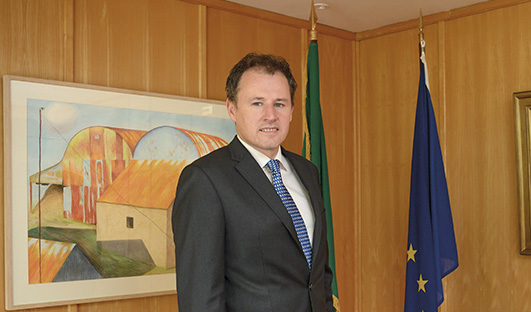


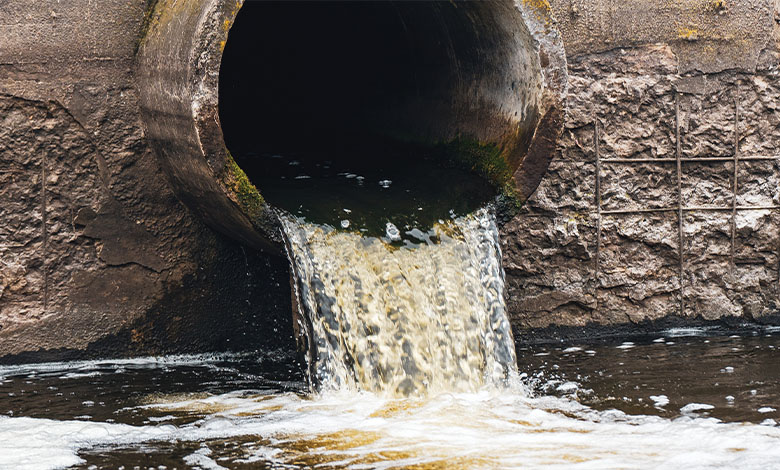
 Ossian Smyth TD
Ossian Smyth TD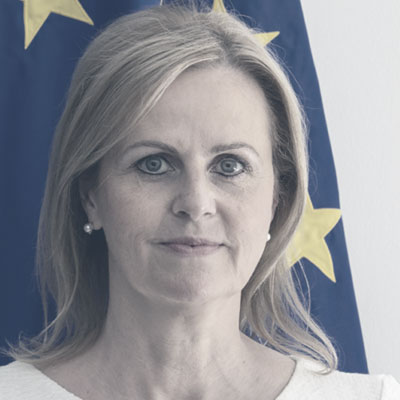 Florika Fink-Hooijer
Florika Fink-Hooijer Antoine Oger
Antoine Oger Laura Curtis-Moss
Laura Curtis-Moss Anthony Costello
Anthony Costello Anja Murray
Anja Murray Niall Ó Donnchú
Niall Ó Donnchú Mike Savage
Mike Savage Brian Carroll
Brian Carroll Claire Downey
Claire Downey Oisín Coghlan
Oisín Coghlan Stephen Onakuse
Stephen Onakuse Kevin O’Sullivan
Kevin O’Sullivan Susan Hegarty
Susan Hegarty Hendrik W van der Kamp
Hendrik W van der Kamp Philip Nugent
Philip Nugent Adrian Smyth
Adrian Smyth Ainhoa Gonzalez Del Campo
Ainhoa Gonzalez Del Campo Geoff Doole
Geoff Doole Clare Pillman
Clare Pillman David Greenfield
David Greenfield Danielle Conaghan
Danielle Conaghan Peter McEvoy
Peter McEvoy Triona McGrath
Triona McGrath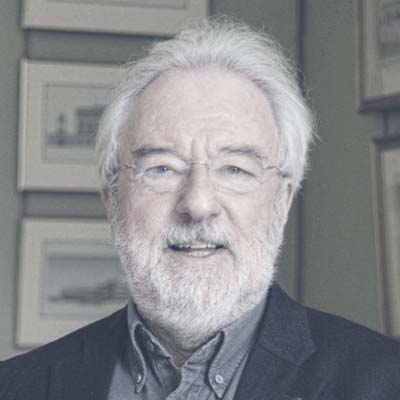 J Owen Lewis
J Owen Lewis Gavin Smith
Gavin Smith Imelda Hurley
Imelda Hurley Lucy Gaffney
Lucy Gaffney Dr Venkatesh Kannan
Dr Venkatesh Kannan Kevin Hegarty
Kevin Hegarty Eimear Cotter
Eimear Cotter Aditya Arora
Aditya Arora Patric Child
Patric Child Eleanor Roche
Eleanor Roche Andy Bleasdale
Andy Bleasdale Andrew Muir MLA
Andrew Muir MLA Chris Hewitt
Chris Hewitt Francesca Racioppi
Francesca Racioppi Danielle Conaghan
Danielle Conaghan Christopher Hammond
Christopher Hammond Laura Díaz Anadón
Laura Díaz Anadón Lorna McAdoo
Lorna McAdoo Conor Murphy
Conor Murphy Mark Horton
Mark Horton Niall McLoughlin
Niall McLoughlin Zoe Kavanagh
Zoe Kavanagh Niall Ó Donnchú
Niall Ó Donnchú Venkatesh Kannan
Venkatesh Kannan David McGee
David McGee Anna Rose
Anna Rose Paul Hogan
Paul Hogan






















 Levent Ergin
Levent Ergin Veronica Manfredi
Veronica Manfredi Francis Finnerty
Francis Finnerty  Timmy Dooley TD
Timmy Dooley TD  Julie Thompson
Julie Thompson  Mark Thuillier
Mark Thuillier  Martin Hutchings
Martin Hutchings  Mark Nolan
Mark Nolan